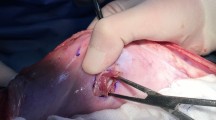Abstract
Background
Laparoscopic ventral hernia repair using an underlay mesh frequently requires suture fixation across the abdominal wall, which results in significant postoperative pain. This study investigates the utility of a novel mesh fixation technique to reduce the strangulation force on the abdominal wall.
Methods
Multiple 2-cm2 pieces of polyester mesh (Parietex Composite, Covidien) were placed as an underlay against a porcine abdominal wall. Fixation was accomplished using either the standard 0-polyglyconate or the 0-polyglyconate barbed anchor suture designed to hold in tissue without the need to tie a knot (V-Loc 180; Covidien). Suture fixation began with a stab wound incision in the skin. A suture-passing device then was used to pass the suture across the abdominal wall and through the mesh. The suture passer was removed and reintroduced through the same stab wound incision but at a different fascial entry point 1.5 cm away. The tail of the suture was grasped and pulled up through both the mesh and the abdominal wall, creating a full-thickness U-stitch. One tail of the suture was attached to a tensiometer, and the strangulation force on the abdominal wall was measured while the suture was tied (standard) or looped (barbed). To compare pullout force, the tensiometer was attached to either the mesh or the suture, and traction was applied until material failure or suture pull through. Results are expressed as mean ± standard deviation. Comparisons were performed using Student’s t-test.
Results
Eight pieces of mesh were placed for each suture. The average force required to secure the barbed suture (0.59 ± 0.08 kg) was significantly less than the force needed to secure the standard suture (2.17 ± 0.58 kg) (P < 0.0001). Table 1 compares the suture pullout forces with the mesh failure forces. Although the pullout force for the standard suture is significantly greater than for the barbed suture, both sutures have a pullout strength significantly greater than the mesh failure force.
Conclusions
A barbed anchor suture used to secure mesh to the abdominal wall requires nearly 75% less strangulation force than a standard monofilament suture while still providing significantly greater pullout force than that required for the mesh to tear and fail. This method of mesh fixation should result in less postoperative pain and warrants a clinical trial.






Similar content being viewed by others
References
Rudmik LR, Schieman C, Dixon E (2006) Laparoscopic incisional hernia repair: a review of the literature. Hernia 10:110–119
Eriksen Jr, Poornoroozy P, Jorgensen LN, Jacobsen B, Friis-Anderson HU, Rosenberg J (2009) Pain, quality of life, and recovery after laparoscopic ventral hernia repair. Hernia 13:13–21
Nguyen SQ, Divino CM, Buch KE, Schmur J, Weber KJ, Katz LB, Reiner MA, Aldoroty RA, Herron DM (2008) Postoperative pain after laparoscopic ventral hernia repair: a prospective comparison of sutures versus tacks. JSLS 12:113–116
LeBlanc KA, Booth WV, Whitaker JM, Bellanger DE (2001) Laparoscopic incisional and ventral herniorraphy: our initial 100 patients. Hernia 5:41–45
Heniford BT, Park A, Ramshaw BJ, Voeller G (2003) Laparoscopic repair of ventral hernias: nine years’ experience with 850 consecutive hernias. Ann Surg 238:391–399
Wassenaar EB, Schoenmaeckers EJ, Raymakers JT, Vander Palen J, Rakic S (2010) Mesh-fixation method and pain and quality of life after laparoscopic ventral or incisional hernia repair: a randomized trial of three fixation techniques. Surg Endosc 24:1296–1302
Bageacu S, Blanc P, Breton C, Gonzales M, Porcheron J, Chabert M, Balique J (2002) Laparoscopic repair of incisional hernia. Surg Endosc 16:345–348
KA LeBlanc (2007) Laparoscopic incisional hernia repair: are transfascial sutures necessary? Surg Endosc 21:508–513
Disclosures
Calvin Lyons, Rohan Joseph, Nilson Salas, Patrick R. Reardon, Barbara L. Bass, and Brian J. Dunkin have no conflicts of interest or financial ties to disclose.
Author information
Authors and Affiliations
Corresponding author
Rights and permissions
About this article
Cite this article
Lyons, C., Joseph, R., Salas, N. et al. Mesh fixation with a barbed anchor suture results in significantly less strangulation of the abdominal wall. Surg Endosc 26, 1254–1257 (2012). https://doi.org/10.1007/s00464-011-2014-5
Received:
Accepted:
Published:
Issue Date:
DOI: https://doi.org/10.1007/s00464-011-2014-5




